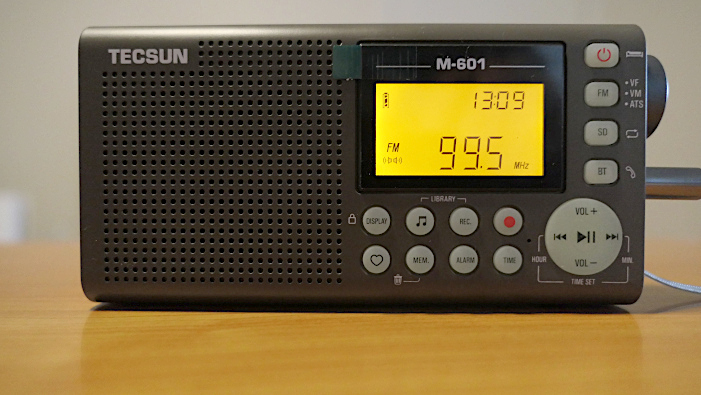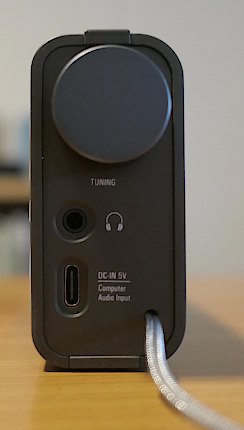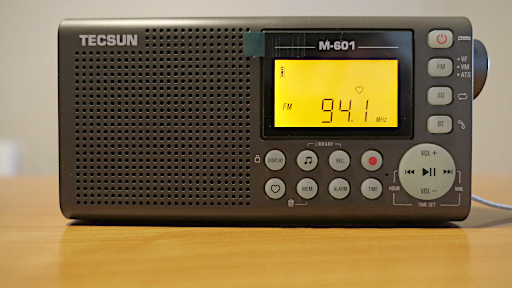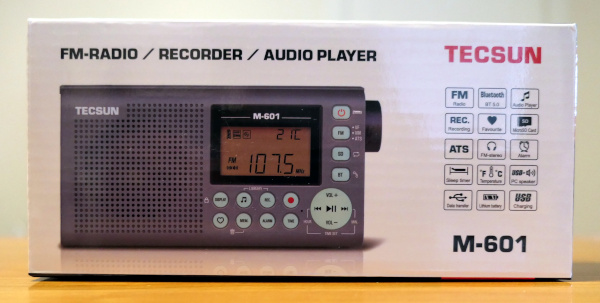
This is an initial, relatively brief review of the Tecsun M-601. I will add to this review once I'm able to test the playback and recording functions of this model. For now, the review focuses mostly on the M-601's FM radio.
In addition to its "PL" line of high-performance radios, the Chinese manufacturer Tecsun has radio models that include MP3 players and recorders. Tecsun's ICR-100 and ICR-110 models include MP3 playback and recording capabilities. In 2024, Tecsun rolled out a new line of such devices, with model numbers beginning with "M". (You can see them at tecsun-radios.com.) Most aren't available in the United States. The M-601 is the exception, available from Amazon and eBay sellers for around $40 in late 2024. No case is provided. A USB-C cable is included.

What intrigued me about this radio was its resemblance to the high-performance Tecsun PL-320, including the same medium-gray color and rounded corners on its case and a very similar display. Both also use USB-C ports (left) for charging their batteries. The PL-320's battery is removable; the M-601's battery (type 104050) is built into the unit and can't be removed. Both use lithium-ion batteries.
One note about the headphone jack: it appears to be incompatible with "TRRS"-type plugs, such as those used on earbuds that also have a microphone. Either use a standard "TRS" plug or stick an adapter or passive volume control between the radio and the earbuds. If the plug has two rings on the shaft, no problem; if there are three rings on the shaft, then there will be a problem.
The PL-320 is purely and simply a radio, while the M-601 includes a player for audio files and a recorder that creates MP3 files. Those files go on a microSD card that's inserted into a slot in the bottom of the unit.
The M-601 can also connect to a phone or other device via Bluetooth, allowing those devices to play their audio through the M-601's speaker. Finally, it can use its USB port to connect to a computer, which lets the computer play back audio through the M-601's speaker.
There's a lot to check out here, but, for now, I'll focus mostly on the radio.
FM radio
The M-601 is an FM radio only: no AM, no shortwave. There's no whip antenna. Instead a wrist strap doubles as an antenna, similar to Tecsun's ICR-100 model. This does present the prospect for reduced reception capability, but the radio seems to work fine in an urban area. More on performance farther down in this review.
A single knob on the right side of the radio controls both volume and tuning. The large round button on the lower right front of the radio determines what the knob will do. If the button was last used to control volume, by pressing either the top or bottom of the button, then the knob also controls volume. If the button was last used to tune to a different station, by pressing the left or right side of the button, then the knob also will tune among stations.
This is a bit unhandy, especially for tuning among stations, but it's not difficult. Tuning with the knob can be slow. A quicker approach is to allow the radio to memorize all local stations (press and hold the FM button) and then tune among memory positions. The M-601 doesn't have the second bank of "Easy Tuning Mode" (ETM) memory that many other Tecsun radios have, but I don't think it really needs ETM.
You can switch between memory tuning and tuning by frequency by short-pressing the FM button. When tuning by memory position is used, the number of the memory position being used (they're assigned sequentially) is shown in the upper-right corner of the display.
The automatic memory function (ATS) does a good job of avoiding "false" signals such as HD sidebands that the radio doesn't decode. The Tecsun PL-320 also avoids this problem, which was a common issue with older Tecsun models. Using the MEM button, memory positions can also be defined manually one-by-one, and memory positions can be deleted by a long press of the MEM button.

Just as with the PL-320, there's the ability to designate a favorite station, using the button with a heart symbol. When tuned to the favorite station, the heart symbol appears in the radio's digital display (right). I've used this to store a station (actually a translator that's a little too far away) that ATS didn't pick up but that I can still hear when in the right locations in my house.
Memory functions also come into play when setting the alarm. The alarm can be set to use either the radio or the audio player. The station or audio track used for this purpose also has to be set in advance.
The M-601's ATS also provides a good indication of the radio's performance. In lieu of a head-to-head comparison between the M-601 and other radios, I decided to use some of the results from my August 2024 comparisons, which included the PL-320 as well as the Qodosen DX-286, which are the most sensitive radios I had at the time of this review.
To adjust for the wrist-strap antenna, and the likelihood that the ATS function wouldn't latch onto weak signals, I filtered out the weaker stations (signal levels 2 or below) from the August 2024 results for the PL-320 and the Qodosen DX-286. Then I counted the number of stations the M-601's ATS picked up. The results:
- Tecsun M-601: 40 stations with ATS
- Tecsun PL-320: 41 stations with signal strength 3 (moderate) to 5 (perfect).
- Qodosen DX-286: 43 stations with signal strength 3 to 5.
While not as precise as my August 2024 testing procedure, this does indicate that the M-601 can hold its own, at least as far as moderate-strength (or better) signals are concerned. The wrist-strap antenna plus the somewhat sluggish tuning make it more difficult to pick up weak or faint signals.
Selectivity is good. The M-601 can separate the Denver-area "Aurora Triangle" of translators and an LPFM at 93.7, 93.9, and 94.1 MHz easily, just as do the PL-320 and the Qodosen DX-286.
While the radio isn't a top performer, it's pretty near the top. The standout here, though, is the speaker. It has a lot of power for such a small unit and, while no boom box, it has a very good tonal balance and is pleasant to listen to, especially for spoken-word programming. Tecsun's specifications state that the speaker is powered by a three-watt amplifier. It definitely has a beefier sound than the PL-320.
The MP3 recorder

The M-601 can record broadcasts from the radio with just a press of the recording button (indicated by a red circle). The MP3 format is used with a bitrate of 160 kbps. However, just as with the ICR-100 and the ICR-110, a low-pass filter is used. In the case of the M-601, that filter limits the upper frequency response to 11.5 kHz. FM broadcasts are capable of frequency response up to 15 kHz, so this is something of a disappointment, relegating these recordings to cassette-tape quality. I wish Tecsun hadn't implemented such a filter.
If a phone is connected to the M-601 via Bluetooth, phone calls can also be recorded. Those recordings will be at a lower quality level, but that's appropriate given that cellular phone calls are low-fidelity and heavily compressed anyway.
The M-601 also can record from a built-in microphone. This occurs when the recording button is pressed when the radio is in SD (audio-player) mode.
The microSD card used for recordings can have a maximum capacity of 128 GB.
The audio player
This function hasn't been tested yet. I'll revise this review once I'm able to try it out.
The manual for the M-601 states that FLAC, WAV, WMA, and MP3 (up to 320 kbps) formats are all supported by the player.
Conclusion
The M-601 is a versatile device with reasonably good FM reception performance and some compromises in its recording capabilities. The wrist-strap antenna limits the radio's FM performance slightly but still works well with even just moderately strong signals. Most people will find that acceptable, I believe.
Given the quality of the audio coming from the speaker, I suspect that the M-601's capabilities have been designed around the speaker. The radio, the audio player, and the Bluetooth and USB functions all appear to take advantage of the good-quality sound that the unit is capable of. The M-601 performs multiple functions with fewer compromises than one might have suspected.